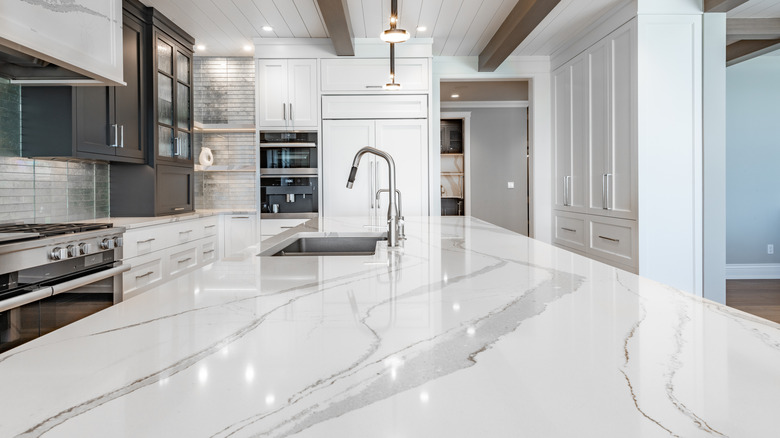Home Improvement
6 Reasons to Use Floor Protection

Did you know floor protection is required by law in many places? This means you need to cover the floor if your surface material is not durable enough or can’t be replaced. Protection products, such as floor protector pads and floor mats, are essential for home or office flooring.
This blog post discusses six different reasons why floor protection should be used in every home or office.
- Provides Better Shock Absorption
The primary goal of investing in surface protection is to keep your home or workplace safe from slipping accidents. More often, people will slip on their floor because many hard surfaces lack shock absorption features.
A good floor mat will have excellent insulation against shock or impact, preventing severe injuries when someone slips. This is more applicable to working adults who spend most of their day on the floor.
Also, it absorbs impact, reducing the risk of breaking a tile if someone accidentally hits an exposed object.
- Protects the Surface from Scuffs and Scratches
Good floor protection products will safeguard your floor from scratches and scuffs. It’s no doubt that hard floor surfaces are not always durable. This is regardless of if they are made of wood or ceramic tiles.
A good surface protector safeguards the existing floor from getting scratched by office furniture or other equipment. Therefore, investing in floor protection products such as metal mats and rubber mats is vital.
It helps you to avoid hurting yourself and increasing the risk of damaging your flooring system.
- Improves Floor Aesthetic and Hygiene
Floor coverings such as vinyl floor runners and carpeted area rugs offer better surface protection and decoration. They’re stylish and prevent scratches and discoloration from taking place.
It protects your floor from dust, hair, and dirt, which might cause hygiene problems if left unattended for too long. This provides a better image of the workplace since it doesn’t look dirty and messy up close.
If you have children at home who are careless around the house, you need these floor protectors. A protective floor covering, such as floor mats, around the home will keep you from worrying about where they’re stepping next.
In case they accidentally spill water onto the floor, carpet runners will absorb the liquids. This safeguards the surface from damage and becoming slippery. They protect flooring systems from water damage.
But which surface protections work better in areas prone to regular liquid spills?
The use of plastic matting on top of leather floor mats or black hexagon floor tile effectively absorbs liquid spills. It prevents damage to your surface and helps minimize the effort it takes to dry off wet spots.
For this reason, laying down vinyl runners, which are waterproof, provides a better defense mechanism against accidents for busy homeowners.
If you’re planning on investing in laminate flooring, then install hallway runner carpets. They add extra insulation against sound pollution, especially if you have wooden floors.
Carpet floor runners have a significant sound insulation effect, which can help reduce noise from outside. Besides, they’re more useful during the winter to prevent your hallway surface from getting frozen.
- Maintains Your Flooring System Investment
No matter how careful you are, accidents will happen at some point. This is where floor protection products such as floor mats for offices come into play if you have flooring systems installed.
Floor mats will absorb most of the impacts thrown on the surface. Thus, floors will only get minimal damage from these events instead of being torn out because of severe impacts. You may even end up saving money since floor protection products need regular change like the floor tiles would.
You won’t damage the floor by placing protection products in your home or office key areas. They’re an investment that’ll serve you for several years, giving you value for your money.
- Temporary Floor Protection
If you’re unsure what floor covering you want to use, go here for the best flooring protection materials. They’ll provide several options that’ll be ideal for your surfaces.
You need floor covers that are easy to put down, move around, and remove when necessary. For example, floor protection paper can be effective in temporary flooring.
- Construction floor protection
When people are renovating their properties, they must protect all flooring properly. The protection will keep the floors intact while working. Also, it’ll give the new surfaces a better chance of staying undamaged.
When the remodeling is in progress, different paint stains or cement drops can discolor your surface tiles. You don’t want to spoil your beautiful tiles with such. Thus, the need to have the best construction floor protection installed.
Common Types of Floor Protectors
People need to protect their floors from damage to avoid regular repairs. This can be done with different flooring materials, depending on the type of ground.
Exterior Floor Sealer
One of the most critical floor protections is an exterior floor sealer for stone, tile, and brick flooring. It protects against spillage, debris, and stains that come from weather and traffic elements.
Floor Tape
If you’re looking for a floor protection type that’s affordable and easy to install, look for floor tape. It works better when lining aisles, stairwells, and floor service areas.
Floor Mats
Mats can help when you’re walking on slippery surfaces. They stop dirt, water, oil, and other things from getting to the floor and later damaging it or causing injury.
Floor Rugs
These rugs are essential in the prevention of surface damage for high-traffic areas like entryways and lobbies. Besides, they provide excellent protection to surfaces that experience frequent seat moves.
Interlocking Floor Protection
These mats prevent dirt, water, and floor spills from occurring. They’re suitable for hallways, industrial entryways, and busy meeting areas.
Other floor protections available in the market today include:
- Floor clocks
• Floor mats with built-in floor storage
• Floor stickers
Invest in the Most Durable Floor Protection Now
People often think floor protection is a waste of time, money, and effort. However, that is not the case. Floor protection can be a lifesaver in more ways than one.
Found this article informative? Bookmark our blog or subscribe to our email to receive more floor protection tips.
Home Improvement
Top 10 Plumbing Maintenance Tips Every Homeowner Should Know


Property owners must ensure the longevity and functionality of their plumbing systems by providing adequate plumbing assistance. Regular maintenance improves overall water quality, reduces spills, and saves costly repairs. The top 10 plumbing maintenance suggestions that every property owner should be aware of are listed below.
Assess for Spills Routinely
Normal assessments for spills are imperative to keeping up your plumbing framework. Property holders ought to routinely check fixtures, toilets, and beneath sinks for water stains or puddles, which may show a spill. Early discovery of spills can spare considerable sums of water and anticipate auxiliary harm to your domestic.
Schedule Cleaning to Prevent Clogs
Significant plumbing problems might result from clogged channels. Clog danger can be reduced by taking preventative measures like installing strainers in showers and sinks. A seamless waste structure can be ensured by scheduling expert cleanings, which can help remove any hidden obstructions deep within the channels.
Take Caution While Flushing Something
The things you flush down the canister might have a big impact on your pipes. Waste materials including food scraps, paper towels, and hygiene products should be disposed of with the trash; human waste and toilet paper should be flushed. One way to avoid obstructions is to teach everyone in the household how to flush virtually legitimately.
Maintain the Water Radiator
In order to guarantee sustainability and safety, your water radiator has to receive real assistance. Sludge accumulation can affect heating performance and raise utility costs; nevertheless, regular flushing of the water radiator makes a clear contrast. In order to safeguard a temperature setting of 120°F5, it is suggested that the tank be flushed at least once a year and the indoor controller checked.
Understand the Location of Your Basic Water Shut-Off
Understanding where your basic water shut-off valve is in an emergency can save you from severe water damage. Owners of the property should locate this valve and ensure that everyone in the household is aware of its location. Testing the valve on a regular basis can also ensure that it operates correctly.
Verify the Water Weight
Maintaining the proper water weight in your plumbing system is essential. While height weight can damage channels and equipment, moo water weight may indicate a spill. Owners of properties should measure the water’s weight with a weight gauge and see a plumber if any significant variations are noticed.
Clear Out Your Channels
It is essential to plan thorough cleaning in order to prevent reinforcements and obstructions. Mortgage holders can enhance depletion maintenance by using a monthly solution of boiling pop and vinegar mixed with hot water to break down accumulation. Effective cleaning may be necessary to remove blockages from problematic clogs.
Evaluate the Sewer Channels
Sewer channel routine inspections can be planned to prevent significant plumbing problems. At the very least, once every six months, property owners should have their sewer systems inspected to look for obstructions or root penetration. By taking preventative measures, you can help identify problems before they become serious and avoid costly repairs.
Safeguarded Your Networks
For your channels to avoid hardening and bursting throughout the winter, protection is especially important in colder locations. Mortgage holders should use foam or fiberglass sleeves to cover any exposed passages in areas such as storm cellars and higher rooms. The costly repairs associated with burst channels can be avoided with this security.
Fill up Any Holes with Caulk
Over time, spills and water damage may result from holes around plumbing installations. Owners of real estate should examine the areas where pipes touch walls or flooring and caulk any gaps as needed. Caulking not only prevents spills but also increases life and effectiveness by maintaining a climate-controlled interior.
Mortgage holders may ensure that their plumbing systems operate efficiently and prevent unexpected repair expenses by taking advantage of these plumbing assistance recommendations. Regular maintenance also fosters a more secure and reliable home environment.
Home Improvement
Discover the Perfect Bedside Table for Your Room in NZ


Introduction to Bedside Tables
A bedside table is a small table you keep next to your bed. It’s really helpful because you can put things like a lamp, your favorite book, or an alarm clock on it. This makes it easy to reach these items when you need them, especially at night. For example, if you need a drink of water, you don’t have to get out of bed. Besides being useful, a bedside table also makes your room look nicer. So, having a bedside table can make your life easier and your bedroom more organized and cozy.
Types of Bedside Tables in NZ
There are many different kinds of you can find bedside table NZ. First, let’s talk about the styles. Some tables are modern and have a shiny, smooth look. They often come in cool colors like black or white. Other tables might be rustic, which means they look a bit like old wood. These tables usually have a warm, cozy feeling.
Next, we can think about the materials used. Bedside tables can be made from wood, metal, or even glass. Wooden tables are strong and last a long time. Metal tables are shiny and can give your room a trendy look. Glass tables look fancy but need careful handling.
Moreover, you should consider what you like and what matches your room. For example, if your room is very colorful, a simple wooden table might be best. But if your room is very plain, a bright, metal table can add some fun. With so many options, you can find the perfect bedside table in NZ for your style!
Choosing the Right Bedside Table for Your Room
Selecting the perfect bedside table for your room in New Zealand can be fun! First, you need to think about the size. Make sure the table is not too big or too small for your space. Measure the area beside your bed and check if the table fits well. You don’t want a table that’s too tall or too short, as it should match the height of your bed.
Next, consider how much storage you need. If you like to keep many things close by, like books or gadgets, choose a table with drawers or shelves. This way, you can keep your things tidy and easy to find. However, if you don’t need much space, a simple table without drawers can be just right.
Finally, think about the table’s look. Pick a table that goes well with your room’s style. For example, if your room is modern, a sleek table might be best. But if your room is cozy, a wooden table might fit better. Remember, the right bedside table can make your room look complete and keep your things organized!
Bedside Tables Available in NZ
In New Zealand, you can find many great bedside tables. Some popular brands offer a wide variety to suit every taste. For example, Betalife has a wonderful collection of bedside tables that are both stylish and practical. They have tables that come in different colors and designs, so you can easily find one that matches your room.
You can also find bedside tables at local furniture stores. Visiting these shops allows you to see and touch the tables before you buy them. This helps you pick the one that feels just right. Plus, buying from a New Zealand store supports local businesses, which is a good thing to do!
If you prefer shopping online, there are many websites where you can find bedside tables. Online stores often have more choices and you can compare prices easily. Just make sure to check the delivery options to see if they can bring the table to your home. Whether you shop in a store or online, you’ll find the perfect bedside table in NZ!
Styling Your Bedside Table
Making your bedside table look nice is easy and fun! First, think about what to put on top of it. A small lamp can give you light for reading or writing at night. You could also add your favorite book or a cute plant to make it feel cozy.
Next, it’s important to keep your bedside table neat. Don’t pile too many things on it because that can make it look messy. Instead, choose a few special items that you use often. For example, you can keep your glasses, a clock, and a small photo frame.
Matching your bedside table with your room’s decor is also a great idea. If your room has bright colors, you can pick a table in a fun color to match. Or, if your room is simple and calm, a table in white or wood can look really nice. Adding little decorations, like a pretty tray or a colorful coaster, can make your bedside table look perfect. With these tips, your bedside table will look great and be very useful too!
Caring for Your Bedside Table
Taking care of your bedside table is important to keep it looking nice and lasting a long time. First, you should clean it regularly. For wooden tables, a soft cloth with a little polish works well. It makes the table shiny and free of dust. If your table is made of glass or metal, you can use a damp cloth to wipe it clean and then dry it with another cloth.
Protecting your bedside table from scratches and stains is also a good idea. Always use coasters under your drinks to prevent water rings. If you have heavy items, place a soft pad under them to avoid marks on the table.
Moreover, be gentle when you use your bedside table. Don’t slam drawers or put too many heavy things on it. By doing these simple things, your bedside table will stay in great shape. Remember, a well-cared-for bedside table will keep your room looking neat and stylish for years to come!
Summary
Choosing the right bedside table is essential for making your room more practical and stylish. Whether you prefer a modern look or something more classic, there are many options to explore in New Zealand. Remember to pick a table that fits your space, offers enough storage, and matches your room’s decor. Taking care of your bedside table with regular cleaning and protection will keep it looking great for a long time. So, take your time, explore your choices, and find the perfect bedside table that makes your bedroom complete and cozy.
Home Improvement
The Elegant Beauty of Quartz Countertops in Montreal


Key Takeaways:
- Montreal homeowners are embracing quartz countertops for their timeless elegance, durability, and design possibilities.
- Quartz countertops have a sophisticated appearance and come in a variety of colors and patterns to match any style.
- Quartz countertops are highly durable, resistant to scratches and chips, and non-porous, making them easy to clean and maintain.
- With advancements in manufacturing, quartz countertops can mimic the look of natural stone like marble or granite.
- When choosing a quartz countertop, consider the variety of colors and patterns, explore different edge profiles, and consider thickness and finish options.
- Installing quartz countertops enhances the value of a home, requires easy maintenance, and offers resistance to heat, stains, and scratches.
- Working with a professional quartz countertop installer ensures proper selection, installation, and care for the countertops.
- Choosing the right contractor involves research, discussing project requirements, and obtaining estimates and timelines.
- The installation process includes assessing cabinets, taking precise measurements, and securing the countertops with adhesive.
- After installation, proper care and maintenance should be followed to protect the longevity and beauty of the quartz countertops.
Welcome to our comprehensive guide on quartz countertops in Montreal. If you’re a homeowner looking to enhance the beauty and functionality of your kitchen or bathroom, quartz countertops are an excellent choice. In this guide, we will explore why Montreal homeowners are embracing quartz countertops, how to choose the perfect countertop for your home, the benefits of installing quartz countertops and working with a professional installer in Montreal. Let’s dive in!
Why Montreal Homeowners are Embracing Quartz Countertops
Montreal homeowners are increasingly turning to quartz countertops because of their timeless elegance, unmatched durability, and endless design possibilities.
The Timeless Elegance of Quartz
Quartz countertops are known for their elegant and sophisticated appearance. Unlike natural stone countertops, quartz is an engineered stone that is created by combining crushed quartz with resins and pigments. This manufacturing process allows for a wide range of colors and patterns, making quartz a versatile choice for any style of kitchen or bathroom.
Whether you prefer a classic and clean white countertop or a bold and dramatic pattern, there is a quartz countertop to suit your taste. The uniformity of quartz also makes it easy to match with other materials and colors in your space.
Unmatched Durability and Resistance
One of the key reasons why Montreal homeowners choose quartz countertops is their durability and resistance. Quartz is an incredibly hard material, ranking 7 on the Mohs hardness scale (just below diamonds). This hardness ensures that quartz countertops are resistant to scratches and chips, making them perfect for high-traffic areas like kitchens.
Additionally, quartz countertops are non-porous, meaning they are highly resistant to stains and bacteria growth. This makes them an excellent choice for kitchens where spills and food preparation are common. With proper care and maintenance, quartz countertops can retain their beauty and durability for many years.
Endless Design Possibilities
Another reason why Montreal homeowners are embracing quartz countertops is the endless design possibilities they offer. With advancements in manufacturing technology, it is now possible to create quartz countertops that mimic the look of natural stone like marble or granite.
Quartz countertops can be customized to fit any style or design preference. Whether you prefer a minimalist and sleek look or a more intricate and detailed pattern, quartz countertops can be tailored to your exact specifications. This versatility allows homeowners to create their dream kitchen or bathroom without compromising on aesthetics.
Choosing the Perfect Quartz Countertop for Your Montreal Home
When it comes to choosing the perfect quartz countertop for your Montreal home, there are several factors to consider. These include understanding the variety of colors and patterns, exploring different edge profiles, and considering thickness and finish options.
Understanding the Variety of Colors and Patterns
Quartz countertops come in a wide range of colors and patterns to suit every style and design preference. From classic white and gray to bold and vibrant colors, there is a quartz countertop to match any color scheme. You can choose a solid color for a minimalist look or opt for a patterned quartz countertop to add visual interest to your space.
When selecting a color or pattern, consider the overall aesthetic of your kitchen or bathroom. Do you prefer a neutral palette or something more bold and eye-catching? Take into account the other elements in the room, such as the cabinetry, backsplash, and flooring, to ensure a cohesive and harmonious look.
Exploring Different Edge Profiles
The edge profile of a quartz countertop can greatly impact the overall look and feel of your kitchen or bathroom. There are several edge profiles to choose from, including straight, beveled, bullnose, ogee, and more. Each edge profile has its own unique characteristics and can enhance the style of your space.
Consider the style of your home and the overall aesthetic you are trying to achieve when selecting an edge profile. For a modern and sleek look, a straight or beveled edge may be the perfect choice. If you prefer a more traditional and elegant look, an ogee or bullnose edge profile can add a touch of sophistication to your countertops.
Considering Thickness and Finish Options
Quartz countertops are available in different thicknesses, typically ranging from 1.2cm to 3cm. Thicker countertops can create a more substantial and luxurious look, while thinner countertops can provide a more contemporary and streamlined appearance. Consider the style and design of your kitchen or bathroom when choosing the thickness of your quartz countertop.
In addition to thickness, quartz countertops also come in various finishes, including polished, honed, and leathered. A polished finish provides a glossy and reflective surface, while a honed finish offers a matte and smooth appearance. A leathered finish has a textured and tactile feel, adding a unique touch to your countertops. Choose a finish that complements the overall aesthetic of your space and suits your personal preference.
The Benefits of Installing Quartz Countertops in Montreal
There are numerous benefits to installing quartz countertops in your Montreal home, including enhancing the value of your property, easy maintenance and cleanliness, and resistance to heat, stains, and scratches.
Enhancing the Value of Your Home
Quartz countertops are a desirable feature in any home and can significantly enhance its value. They are considered a premium material and are often sought after by potential homebuyers. By installing quartz countertops in your kitchen or bathroom, you can increase the resale value of your property and attract more buyers when the time comes to sell.
Easy Maintenance and Cleanliness
One of the main advantages of quartz countertops is their ease of maintenance and cleanliness. Unlike natural stone countertops, quartz does not require sealing or special cleaning products. Simply wiping the surface with a mild soap and water solution is usually sufficient to keep your quartz countertops looking their best.
Due to their non-porous nature, quartz countertops are highly resistant to stains, making them easy to clean and maintain. This is especially beneficial in kitchens where spills and food preparation are common. With quartz countertops, you can spend more time enjoying your space and less time worrying about upkeep.
Resistance to Heat, Stains, and Scratches
Montreal homeowners love quartz countertops for their remarkable resistance to heat, stains, and scratches. While it is not recommended to place hot pans directly on quartz countertops, they can withstand moderate temperatures without being damaged.
Quartz countertops are also highly resistant to stains caused by common household products, such as coffee, wine, and oil. Unlike natural stone countertops, quartz does not absorb liquids, preventing permanent staining. Additionally, the hardness of quartz makes it resistant to scratches from knives and other sharp objects, ensuring your countertops stay beautiful for years to come.
Working with a Professional Quartz Countertop Installer in Montreal
When it comes to installing quartz countertops in your Montreal home, it is essential to work with a professional installer who has experience and expertise in handling quartz. Professional quartz countertops or comptoir quartz Montreal can guide you through the selection process, ensure a proper installation, and provide advice on care and maintenance. Here’s what you need to know:
Choosing the Right Contractor for Your Project
Before hiring a quartz countertop installer, it is crucial to do your research and choose the right contractor for your project. Look for a reputable company with a track record of successful installations and satisfied customers. Read reviews, ask for references, and verify their credentials and certifications.
When meeting with potential contractors, discuss your project requirements and expectations. A professional installer should be able to provide guidance on color selection, edge profiles, and other design considerations. They should also provide a detailed estimate and timeline for the installation.
Understanding the Installation Process
The installation process for quartz countertops involves several steps to ensure a precise and secure fit. First, the existing countertops will be removed, and the cabinets will be assessed for any necessary repairs or modifications. Next, precise measurements will be taken to create templates for the quartz countertops.
Once the countertops are fabricated, they will be delivered to your home for installation. The installer will carefully position the countertops, ensuring a perfect fit and alignment. They will then secure the countertops to the cabinets using adhesive and install any necessary sink or cooktop cutouts.
Ensuring Proper Care and Maintenance
After the installation is complete, your quartz countertop installer should provide you with instructions on how to properly care for and maintain your countertops. This may include recommendations on cleaning products, precautions to take with hot items, and tips for preventing damage.
Follow these guidelines to ensure the longevity and beauty of your quartz countertops. Regularly clean spills and messes promptly, use cutting boards and trivets to protect the surface and avoid harsh cleaning products that may damage the finish.
In conclusion, quartz countertops offer a perfect blend of elegance, durability, and versatility for Montreal homeowners. Whether you’re looking to enhance the value of your home, enjoy easy maintenance and cleanliness, or have countertops that resist heat, stains, and scratches, quartz is an excellent choice. By working with a professional quartz countertop installer, you can ensure a seamless and successful installation process. Create a kitchen or bathroom that truly reflects your style and personality with quartz countertops!
-



 Biography6 years ago
Biography6 years agoJacqulyn Elizabeth Hanley is the Mother of Liza Soberano?
-



 Home5 years ago
Home5 years agoEpson L3110 Driver Free Download Latest Updated Version
-



 Games3 years ago
Games3 years agoBest Free To Play MMORPG To Try This 2021
-



 Biography5 years ago
Biography5 years agoAmanda Levy Mckeehan Biography, Family, Net Worth, Age, Affairs, Facts
-



 Biography5 years ago
Biography5 years agoWho is Rose Dorothy Dauriac? Scarlett Johansson Daughter?
-



 Biography5 years ago
Biography5 years agoJessica Ditzel Secret Information that Nobody Knows | Joe Rogan’s Wife
-



 Biography6 years ago
Biography6 years agoWhat is the relation of Nathaniel Larry Osorno with Liza Soberano?
-



 Anime5 years ago
Anime5 years agoOne Piece Filler | The Complete Guide and Updated List 2020































